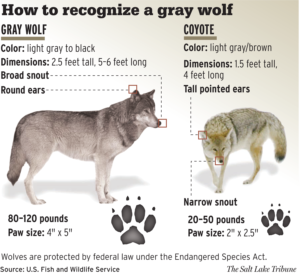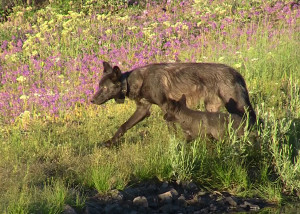Extermination. Seen as incompatible with the settlement of the West, the gray wolf was trapped, poisoned and shot by state and federal governments and private bounty hunters to the point of near extinction.
Protection. The species had been listed on the federal Endangered Species Act (ESA) since the 1973. A year after being delisted in 2021, a federal district court has re-instated ESA protections for gray wolves as of February 2022. This includes wolves in Oregon, but does not include wolves in the Greater Yellowstone ecosystem.
Recovery efforts. To expedite recovery in the Rocky Mountains, the US Fish and Wildlife Service, the federal agency in charge of recovering endangered species, seeded central Idaho and Yellowstone National Park with 29 gray wolves from nearby Canada in 1995 and 37 more in 1996. As anticipated, wolves have repopulated the northern Rockies and have migrated to neighboring states where recovery has begun in earnest.
 In 1999, three wolves journeyed into Oregon from Idaho. One was shot and killed, one was hit by a car and killed, and the other was tranquilized and sent back to Idaho.
In 1999, three wolves journeyed into Oregon from Idaho. One was shot and killed, one was hit by a car and killed, and the other was tranquilized and sent back to Idaho.
Because the state has a statutory obligation under the Oregon Endangered Species Act to recover the gray wolf, the Oregon Department of Fish and Wildlife convened diverse stakeholders to generate a gray wolf recovery plan in 2003.
During the planning process, Cascadia Wildlands mobilized community members across the state, testified at hearings, hosted presentations and submitted official comments on the plan. The plan was adopted by the Oregon Department of Fish and Wildlife Commission in 2005 and set recovery goals for the species in both eastern and western Oregon.
End-of-year 2021 counts in Oregon documented at least 175 wolves across approximately 21 packs, of which 16 were breeding pairs. In Washington, the 2018 count came in with at least 126 wolves in 27 packs, including at least 15 breeding pairs. In California, the lone Shasta Pack has established a territory near the namesake volcano.
Multimedia:
July 2012 | Snake River Pack and Pup Howling
On July 25, 2012, an ODFW wolf biologist on a survey for wolf pups took this video of a Snake River wolf pack pup howling. The video was taken in the Summit Ridge area within the Snake River Wildlife Management Unit, in Wallowa County.
December 2010 | Imnaha Pack
Oregon Department of Fish and Wildlife captures video of the Imnaha Pack alpha female with two pups on December 30, 2010.
January 2008 | First Wolf Confirmed in Oregon
First aerial footage verifying presence of Gray Wolf B-300, radio collared in Idaho and dispersed into Oregon.
Links and Resources:
- Current Oregon Wolf Conservation and Management Plan
- Oregon Department of Fish and Wildlife Gray Wolf Webpage
- View photos of Oregon’s wolves
- Specific Wolves and Wolf Packs in Oregon
- View the Wildlife Management Units (WMU) and where they are located (they are listed under “Controlled Hunts Maps” only as a means to identify where wolf packs are located in the state, NOT indicating that wolves are hunted)
- Testimony from scientists in October 2015 on ODFW delisting decision
- Film made by Clemens Schenk about OR-7
- Documentary film made that retraces the journey of OR-7
- Documentary film How Wolves Change Rivers
Scientific Articles On Wolves and Wolf Recovery:
- Talk by Dr. Adrian Treves on living among wolves and protecting predators
- Scientific study on lethal vs. non-lethal control of predators that appeared in the Frontiers in the Ecology and the Environment, peer-reviewed scientific journal
- Article in Conservation Magazine that questions killing predators to protect livestock
- Wood River Wolf Project non-lethal tool kit for wolf/livestock conflict
- Government-sanctioned culling actually results in more illegal killings
- A more approachable version of the culling concept
- Exposé on Wildlife Services wildlife killing programs in Harper’s Magazine February 2016 issue
- Article on wolf “dialect” in howling patterns
- December 2015 piece written by Nick Cady, Legal Director for Cascadia Wildlands “From Exterminated to a Rebounding Population: A Brief History of Wolves in Oregon”
- Scientific monograph on impacts of loss of breeding wolves to social structure of the pack, reproduction and population growth
- Scientific monograph in the Journal of Animal Ecology on continental trophic cascades for large carnivores including the implications for recovery of wolf populations
- Scientific study on lethal control of wolves and how it co-relates to increases in livestock depredation
- January 2013 piece written by former Cascadia Wildlands Executive Director, Bob Ferris about the philosophical and cultural roots of wolf hatred
- Article by David Mech, wolf researcher and founder of International Wolf Center
- Scientific monograph on wolf reproduction and adaptation to various environmental factors
- Updates from the OSU/ODFW Wolf-Cougar Research Project
- Wolf/Livestock Conflict Research from Washington State University
- Scientific monograph on dispersal dynamics and genetic diversity in wolf populations
- Article that details the impacts wolves have had on Yellowstone since their reintroduction in 1995

